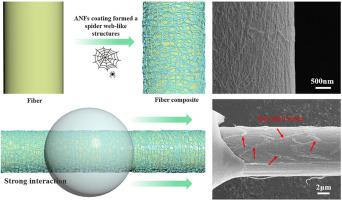在界面构建蜘蛛丝激发的纳米纤维网络增强芳纶纤维复合材料的界面粘附性
IF 9.8
1区 材料科学
Q1 MATERIALS SCIENCE, COMPOSITES
引用次数: 0
摘要
聚对苯对苯二甲酰胺(PPTA)因其优异的机械性能和化学稳定性而受到高度重视;然而,其固有的光滑和化学惰性表面严重限制了其先进应用的潜力。在这项研究中,我们提出了一种复杂的表面工程策略,以显着提高纤维的表面性能。通过采用精确控制的纤维表面结构设计,我们集成了均匀的蜘蛛网状芳纶纳米纤维(ANFs),以协同提高表面粗糙度和活性官能团的浓度。首先通过等离子体辐照改善PPTA纤维表面的惰性结构,然后使用3-氨基丙基三乙氧基硅烷(APS)作为桥接剂增强PPTA纤维与ANFs之间的界面键合,同时修复纤维表面的缺陷。得益于大量的活性官能团,以及在纤维表面涂覆均匀的蛛网状纳米纤维网络所产生的表面粗糙度的改善,纤维复合材料的性能得到了显著提高。其中,界面抗剪强度(IFSS)由42.3 MPa提高到64.3 MPa,层间抗剪强度(ILSS)由51.5 MPa提高到73.3 MPa,分别提高了51.9%和42.3%。这远远高于其他报道的工作,而拉伸性能和耐热性几乎保持不变。该研究结果为解决PPTA纤维复合材料弱界面的协同混合桥接过渡策略的设计提供了一种独特的方法。本文章由计算机程序翻译,如有差异,请以英文原文为准。

Enhanced interfacial adhesion of aramid fiber composites by constructing a spider silk inspired nanofiber network at interphase
Poly (p-phenylene terephthalamide (PPTA) are highly regarded for their exceptional mechanical properties and chemical stability; however, their inherently smooth and chemically inert surface severely limits their potential for advanced applications. In this study, we propose a sophisticated surface engineering strategy to significantly enhance the surface performance of fiber. By employing a precisely controlled design of the fiber surface architecture, we integrated homogeneous spider web-like aramid nanofibers (ANFs) to synergistically augment both surface roughness and the concentration of active functional groups. The inert structure of the PPTA fiber surface was first improved by using plasma irradiation, and 3-aminopropyltriethoxysilane (APS) was subsequently used as a bridging agent to enhance the interfacial bonding between the PPTA fibers and the ANFs while repairing the defects on the fiber surface. Benefiting from the large amount of active functional groups as well as improved surface roughness originated form coated homogeneous spider web-like nanofiber network on fiber surface, the performance of fiber composite significantly improved. Specifically, the interfacial shear strength (IFSS) increased from 42.3 MPa to 64.3 MPa, and the interlaminar shear strength (ILSS) improved from the original 51.5 MPa–73.3 MPa, representing increases of approximately 51.9 % and 42.3 %. which is much higher than that of other reported work, while the tensile properties and heat resistance remained almost unchanged. The findings offer a unique method on the design of synergistic hybrid bridging transition strategy addressing the weak interphase in PPTA fiber composites.
求助全文
通过发布文献求助,成功后即可免费获取论文全文。
去求助
来源期刊

Composites Science and Technology
工程技术-材料科学:复合
CiteScore
16.20
自引率
9.90%
发文量
611
审稿时长
33 days
期刊介绍:
Composites Science and Technology publishes refereed original articles on the fundamental and applied science of engineering composites. The focus of this journal is on polymeric matrix composites with reinforcements/fillers ranging from nano- to macro-scale. CSTE encourages manuscripts reporting unique, innovative contributions to the physics, chemistry, materials science and applied mechanics aspects of advanced composites.
Besides traditional fiber reinforced composites, novel composites with significant potential for engineering applications are encouraged.
 求助内容:
求助内容: 应助结果提醒方式:
应助结果提醒方式:


